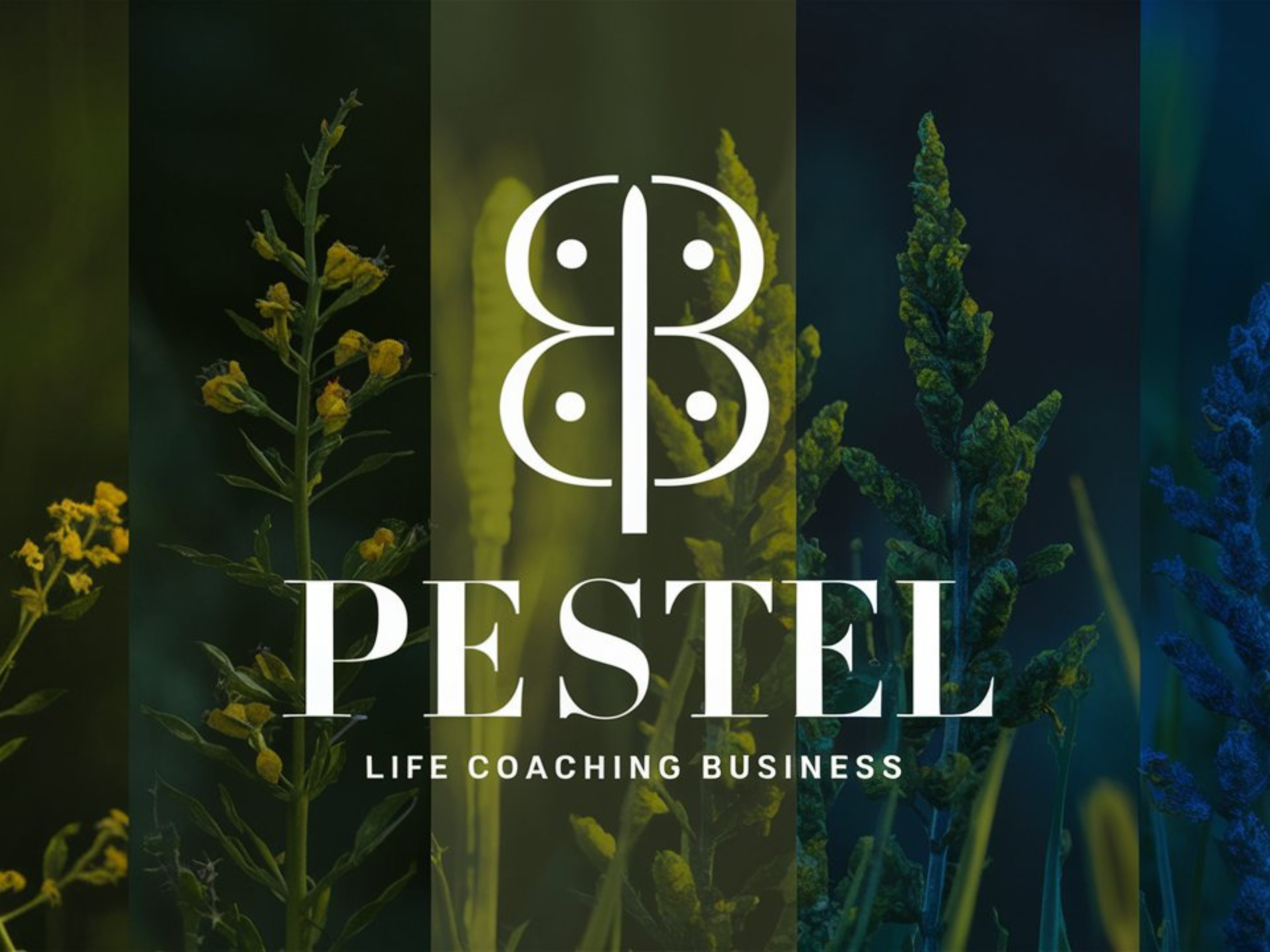Introduction
Completing a strategic analysis requires using tools such as PESTEL. This supports you to improve your understanding of the context you are working in. On its own, PESTEL provides a list of different external forces acting on you, your team, business, or organisation. Read on to see how to turn this into an analytical tool by simply adding opportunities or threats to each analysis. Then see how you take this a step further by adding VUCA analysis.
Bite Size ‘Simple Steps’ (TLDR) – 6 Steps to Implement Strategic Analysis Using PESTEL in a Life Coaching Business
- Define Your Business Purpose
- Action: Clearly identify the main goal or purpose of your life coaching business. This will guide your strategic analysis.
- Example: Your purpose might be to expand your client base by offering online coaching services.
- Conduct a PESTEL Analysis
- Action: Analyse the external environment using the PESTEL tool. Consider the Political, Economic, Sociological, Technological, Environmental, and Legal factors that could impact your business.
- Example: Identify technological factors like the growing trend in online learning platforms and economic factors like potential changes in disposable income.
- Identify Opportunities and Threats
- Action: For each PESTEL factor, determine whether it represents an opportunity, a threat, or both. Mark each factor accordingly.
- Example: The rise of online platforms (Technological) is an opportunity to reach more clients, while economic uncertainty might be a threat to clients’ ability to pay for coaching services.
- Incorporate VUCA Analysis
- Action: Assess each factor in terms of Volatility, Uncertainty, Complexity, or Ambiguity (VUCA). Determine how to address each aspect accordingly.
- Example: The rapid advancement of technology is volatile, requiring agility to stay current with new tools, while economic uncertainty demands gathering more information to mitigate risks.
- Develop Strategic Responses
- Action: Based on the PESTEL and VUCA analysis, develop strategic actions to capitalise on opportunities and mitigate threats.
- Example: Invest in online coaching platforms and digital marketing (opportunity) while offering flexible payment plans to address economic uncertainty (threat).
- Implement and Monitor
- Action: Implement the strategic actions in your life coaching business and regularly monitor the external environment for changes. Adjust your strategies as needed.
- Example: Launch an online coaching program, track its performance, and stay updated on technological trends to make necessary adjustments.

Strategic Analysis
Strategic analysis involves understanding the past, current, and future to provide you with insight into the context of the time and place you are working within. There are several phases to strategic analysis including developing your purpose, analysing the external and internal environment, and identifying key stakeholders. PESTEL is a tool used to support the strategic analysis of the external environment. To understand the role of PESTEL in full strategic analysis and how it aligns with developing and implementing strategy read Simple Steps to Strategy.
PESTEL
The PESTEL tool comprises the headings Political; Economic; Sociological, Technological, Environmental and Legal. It is not new and is widely used across business and public sector organisations to understand the external environment. It is not a rigorous analytical tool but can be improved by application of opportunities, threats and VUCA for additional analysis as outlined below.
Starting with the basic construct of PESTEL, ask the following questions:
Political
Are there any expected political changes or developments which could have an impact, positive or negative, on you and what you are setting out to achieve? This could be national politics or politics within your sector.
Examples include changes of government, change in tax policy or introduction of a new law.
Economic
Are there any known or expected changes in finances which could have an impact on you and what you are setting out to achieve?
Examples include inflation rates, interest rates or new economic policies
Sociological
Are there any known or expected sociological changes which could have an impact on you and what you are setting out to achieve?
Examples include changes in lifestyle, culture, or demographics
Technological
Are there new technologies now or in development which could have an impact on what you are setting out to achieve?
Examples include new technologies such as Artificial Intelligence (AI).
Environmental
Are there environmental factors which could have an impact on what you are setting out to achieve? Consider the potential benefits and risks these could bring.
Examples include climate change, waste disposal, and water quality.
Legal
Are there any legal factors which could impact on what you are setting out to achieve? What are the benefits and risks?
Examples include changes to competition law, employment law
If you are not sure which perspective your theme fits best, do not worry. Remember, this is simply a tool to help you think through the various aspects which can influence what you are doing and choose to do next. If you are not sure whether something is political or legal, just put it in one and move on thinking through the various other themes. Be confident to adapt the tool too, adding on additional sections, such as ethics if this helps you. By now, you will have a range of external factors influencing what you are doing. However, as yet there is no analysis.
Analysis of Opportunity or Threat?
Each aspect identified using the PESTEL tool can be analysed as an opportunity, a threat, or both. Simply mark ‘O’ for Opportunity and ‘T’ for Threat next to the identified theme. These should then help with strategic decision making.
Note, these are not weighted in terms of significance so do not make a strategic decision based on the number of ‘O’ or ‘T’s. One opportunity may negate 10 threats and vice versa. It is also worth being aware of your blind spots and reflecting as you do this on how naturally optimistic or pessimistic you are and how optimistic or pessimistic you are feeling at the time of identifying opportunities and threats. If you are being optimistic, you may identify more opportunities and miss some threats.
VUCA Analysis
Each aspect identified using the PESTEL tool can be analysed as being Volatile, Uncertain, Complex, or Ambiguous. Although collectively termed VUCA, these are all separate aspects each with different ways to address them as illustrated in the table below and described in the following text.
| VUCA Aspect | Approach to addressing this aspect |
| Volatile | Agility |
| Uncertain | Information |
| Complexity | Restructuring |
| Ambiguous | Experimentation |
Volatility
Volatility is a relatively unstable change. Information is available but change is frequent and unpredictable. This is best addressed with AGILITY where resources are directed to building slack into the system to create the potential for future flexibility.
For example, in the UK there can be frequent and sometimes severe changes in the weather within a short period of time. Taking an umbrella and sun cream with you builds agility into your day, to prevent the day being ruled by the volatility of the weather.
Uncertainty
A lack of knowledge of whether events will have a meaningful impact brings uncertainty. INFORMATION is critical. Gathering new data and considering varying perspectives can reduce levels of uncertainty.
For example, when smoke starts to rise from a volcano, it is uncertain whether this will stop or result in lava flows destroying large areas and having a significant impact on people’s lives. All that can be done is monitoring, which provides assurance, improves safety, and reduces the uncertainty.
Complexity
Complexity does not necessarily involve change but when there are many interconnected parts. This is dealt with by RESTRUCTURING.
For example, the internal operations and running of a company may be restructured to match the complexity of the external environment.
Ambiguity
Ambiguity stems from having a lack of basic knowledge of whatever you are dealing with. Cause and effect are not understood and there is no precedent for making decisions. Thoughtful and intelligent EXPERIMENTATION assists with developing the understanding needed to reduce the ambiguity.
For example, when you take up a new sport or start a new role, things can seem ambiguous. By experimenting and learning by doing you progress to reduce the levels of ambiguity.
Summary
PESTEL is a simple tool used as part of strategic analysis to capture thoughts and ideas of the external influences on you, your team, business, or sector. PESTEL can be enhanced by the addition of analysing whether something is an opportunity and /or a threat. It can be developed further again with consideration of Volatility, Uncertainty, Complexity, or Ambiguity. The table below provides a suggested template to use:
| PESTEL | Description | Opportunity and/ or Threat? | Is there Volatility, Uncertainty, Complexity, and/ or Ambiguity? |
| Political | |||
| Economic | |||
| Sociological | |||
| Technological | |||
| Environmental | |||
| Legal |
We hope this has helped you understand the PESTEL tool and provides you with the confidence to use this for strategic analysis. To develop a broader understanding and to find out how PESTEL fits in with other tools to provide you with a strategic analysis, informs strategic decision making to develop strategic plans, take a look at Strategy in Simple Steps.





